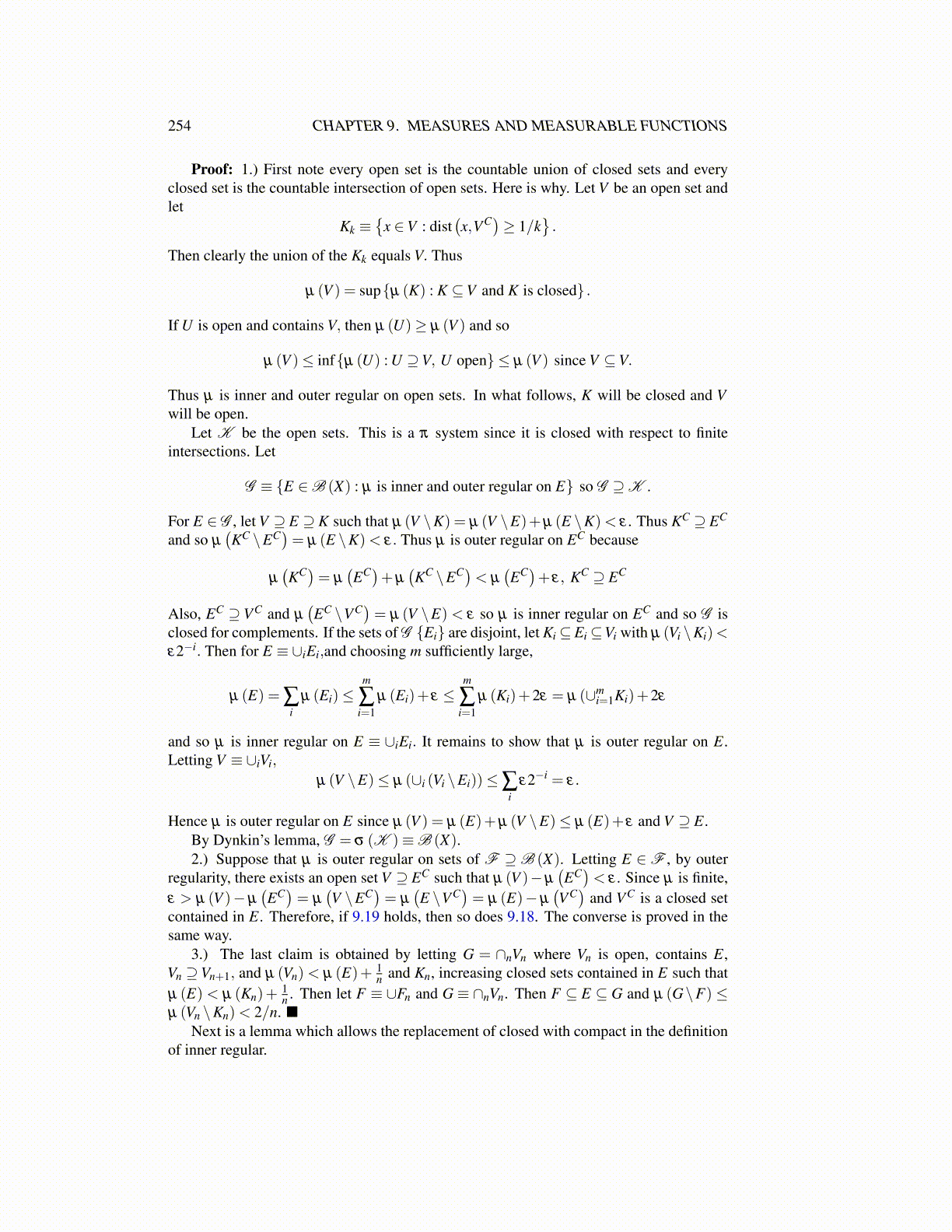
254 CHAPTER 9. MEASURES AND MEASURABLE FUNCTIONS
Proof: 1.) First note every open set is the countable union of closed sets and everyclosed set is the countable intersection of open sets. Here is why. Let V be an open set andlet
Kk ≡{
x ∈V : dist(x,VC)≥ 1/k
}.
Then clearly the union of the Kk equals V. Thus
µ (V ) = sup{µ (K) : K ⊆V and K is closed} .
If U is open and contains V, then µ (U)≥ µ (V ) and so
µ (V )≤ inf{µ (U) : U ⊇V, U open} ≤ µ (V ) since V ⊆V.
Thus µ is inner and outer regular on open sets. In what follows, K will be closed and Vwill be open.
Let K be the open sets. This is a π system since it is closed with respect to finiteintersections. Let
G ≡ {E ∈B (X) : µ is inner and outer regular on E} so G ⊇K .
For E ∈ G , let V ⊇ E ⊇ K such that µ (V \K) = µ (V \E)+µ (E \K)< ε . Thus KC ⊇ EC
and so µ(KC \EC
)= µ (E \K)< ε. Thus µ is outer regular on EC because
µ(KC)= µ
(EC)+µ
(KC \EC)< µ
(EC)+ ε, KC ⊇ EC
Also, EC ⊇ VC and µ(EC \VC
)= µ (V \E) < ε so µ is inner regular on EC and so G is
closed for complements. If the sets of G {Ei} are disjoint, let Ki⊆Ei⊆Vi with µ (Vi \Ki)<ε2−i. Then for E ≡ ∪iEi,and choosing m sufficiently large,
µ (E) = ∑i
µ (Ei)≤m
∑i=1
µ (Ei)+ ε ≤m
∑i=1
µ (Ki)+2ε = µ (∪mi=1Ki)+2ε
and so µ is inner regular on E ≡ ∪iEi. It remains to show that µ is outer regular on E.Letting V ≡ ∪iVi,
µ (V \E)≤ µ (∪i (Vi \Ei))≤∑i
ε2−i = ε.
Hence µ is outer regular on E since µ (V ) = µ (E)+µ (V \E)≤ µ (E)+ ε and V ⊇ E.By Dynkin’s lemma, G = σ (K )≡B (X).2.) Suppose that µ is outer regular on sets of F ⊇B (X). Letting E ∈F , by outer
regularity, there exists an open set V ⊇ EC such that µ (V )−µ(EC)< ε . Since µ is finite,
ε > µ (V )− µ(EC)= µ
(V \EC
)= µ
(E \VC
)= µ (E)− µ
(VC)
and VC is a closed setcontained in E. Therefore, if 9.19 holds, then so does 9.18. The converse is proved in thesame way.
3.) The last claim is obtained by letting G = ∩nVn where Vn is open, contains E,Vn ⊇Vn+1, and µ (Vn)< µ (E)+ 1
n and Kn, increasing closed sets contained in E such thatµ (E) < µ (Kn)+
1n . Then let F ≡ ∪Fn and G ≡ ∩nVn. Then F ⊆ E ⊆ G and µ (G\F) ≤
µ (Vn \Kn)< 2/n. ■Next is a lemma which allows the replacement of closed with compact in the definition
of inner regular.